Today we started our exploring by visiting the Basilica di San Giovanni in Laterano. This is the catherdal of the diocese of Rome and the Pope’s official church as the head of the diocese of Rome. It was first consectated in 324, and was the Pope’s main place of worship until the late 14th century when the papacy moved to the Vatican. Very large and beautiful inside. Large statues of each of the 12 apostles plus Jesus and John the Baptist and John the Evangelist, as well as other artwork. Took some photos, but not able to do justice to the beauty of the interior. Not as (to me) beautiful as the Sistine chapel, but because of its scale, more gob smacking.
Visisted the cloister as will, which is mainly an exhibition of older relics and pieces removed from the main cathedral during renovations over the last 700 years. Also a very peaceful…
After a thorough viewing of the basilica, we wandered over the street to the Scala Santa. These are reputed to be the steps that Jesus walked up to be sentenced by Pontius Pilate. They were brought to Rome by St Helena in the 4th century, and can be climbed today, but only on your knees. Linda was tempted, but did not as she was not sure that her knee was up to it. Instead, we walked up the side steps to view the Sancta Sanctorium (formerly the Pope’s private chapel), and found a 20 Euro note on the stairs. We obviously made the right decision! We decided to donate our good fortune to a fund for the renovation of the steps and associated chapel.
After lunch went to the Basilica di San Celemente. This is a 12th century church, built on a 4th century church (trashed by the Normans in 1084), built on a 2nd century pagan temple and roman house. While the church is another collection of incredible fresco’s and giltwork, the main interest for me is that the basement has been excavated, so that some of the old levels can be explored. The bottom level is 10 m below the current street level, and even the spring that provided water to the Roman house is still running, although it was re-routed in the 1930’s. The old pagan temple of Mithras, with it’s altar showing the god slaying a bull, has been excavated and is visible, as is the alley that separated the house and the temple, and the school as well. An interesting feature was that you can see where each old building was modified to become the foundation for the new – particularly in the original church, the original columns that supported the roof are visible, and you can see where the arches have been filled in to provide more support for the weight of the structure above, and a new roof structure has been built to support the floor of the new basilica. Unfortunately I don’t have photos since the lighting is low, I presume to preserve what remains of the original 4th-11th century frescoes, since it does nothing for helping you get a sure footing in the un-even floor.
- The Scala Santa. I have another picture with people ascending the stairs, but it not showing their best features….
- View of the top of the basilica from the cloister, which is mainly an exhibition of older relics and pieces removed from the main cathedral during renovations over the last 700 years.
- Basilica di San Giovanni in Laterano
- Detail inside the Basilica di San Giovanni in Laterano
- Detail inside the Basilica di San Giovanni in Laterano

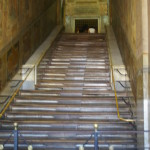
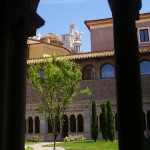
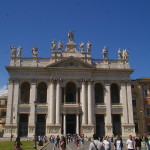
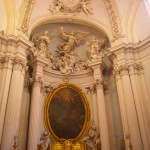
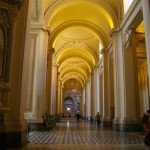


 GooglePlus
GooglePlus Facebook
Facebook Twitter
Twitter